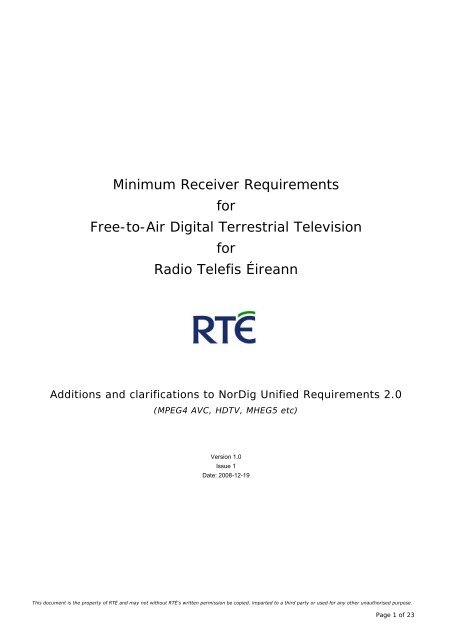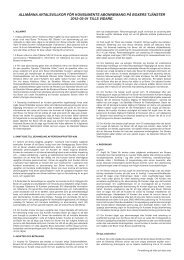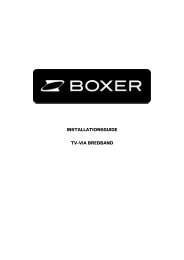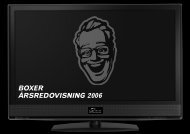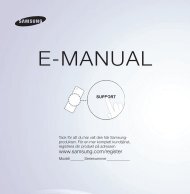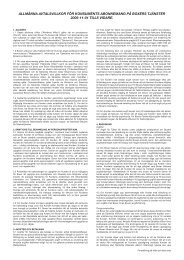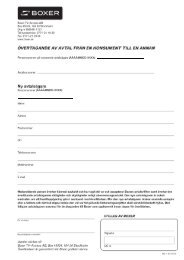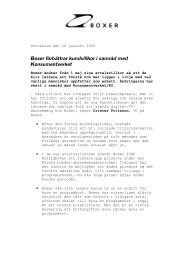Minimum Receiver Requirements for Free-to-Air Digital ... - Boxer
Minimum Receiver Requirements for Free-to-Air Digital ... - Boxer
Minimum Receiver Requirements for Free-to-Air Digital ... - Boxer
Create successful ePaper yourself
Turn your PDF publications into a flip-book with our unique Google optimized e-Paper software.
<strong>Minimum</strong> <strong>Receiver</strong> <strong>Requirements</strong><strong>for</strong><strong>Free</strong>-<strong>to</strong>-<strong>Air</strong> <strong>Digital</strong> Terrestrial Television<strong>for</strong>Radio Telefis ÉireannAdditions and clarifications <strong>to</strong> NorDig Unified <strong>Requirements</strong> 2.0(MPEG4 AVC, HDTV, MHEG5 etc)Version 1.0Issue 1Date: 2008-12-19This document is the property of RTÉ and may not without RTÉ's written permission be copied, imparted <strong>to</strong> a third party or used <strong>for</strong> any other unauthorised purpose.Page 1 of 23
7.1.1. SI Identification coding.................................................................................................. 187.1.1.1. Original Network ID and Network ID............................................................................. 187.1.1.2. Private data specifier values......................................................................................... 187.1.2. Logical Channel Descrip<strong>to</strong>r (in NIT).............................................................................. 187.1.3. Parental rating descrip<strong>to</strong>r (in EIT)................................................................................. 187.1.4. Country and Language Codes within PSI & SI (in “all” tables) ..................................... 187.1.5. Text strings and fields size of the SI descrip<strong>to</strong>rs........................................................... 197.1.6. Reception of multiple DTT networks............................................................................. 207.1.7. User Service Lists......................................................................................................... 218. <strong>Receiver</strong> states ............................................................................................................. 218.1. Installation mode........................................................................................................... 218.2. (Normal TV viewing mode) Active mode....................................................................... 218.3. (Au<strong>to</strong>matic) Update mode............................................................................................. 218.4. Stand-by and power off mode....................................................................................... 229. Controller and Memory ................................................................................................. 229.1. Clarifications <strong>to</strong> NorDig Unified specifications (chapter 11).......................................... 22This document is the property of RTÉ and may not without RTÉ's written permission be copied, imparted <strong>to</strong> a third party or used <strong>for</strong> any other unauthorised purpose.Page 3 of 23
Version 1.0Status Issue 11.2. Document His<strong>to</strong>ryVersion Date Status Comments0.1 2008-11-09 Draft Initial draft document based on Teracom ACD 2.0 document0.1b 2008-11-11 Draft Comment 0.1 draft (comments from Teracom, Per Tullstedt , ptu andPetri Hyvärinen, phy)0.1c 2008-12-17 Draft Amendments <strong>to</strong> 0.1b draft - Marcus O’Doherty1.0 2008-12-19 Issue 1 Final amendments <strong>to</strong> o.1c draft – Marcus O’DohertyContact person(s):1.3. TerminologyManda<strong>to</strong>ry / shallRecommended /shouldOptionalThis word means that the item is manda<strong>to</strong>ry.This word means that this item is not manda<strong>to</strong>ry, but is highly recommended. Ifincluded, then it shall be implemented as specified.This word means that this item is not manda<strong>to</strong>ry, gives added value <strong>to</strong> different IRDimplementations. But if this item is included then it shall be implemented as specifiedhere.This document is the property of RTÉ and may not without RTÉ's written permission be copied, imparted <strong>to</strong> a third party or used <strong>for</strong> any other unauthorisedpurpose.Page 5 of 23
Version 1.0Status Issue 12. General features <strong>for</strong> a digital receiverThe requirements <strong>for</strong> IRDs (integrated receiver decoders) in the DTT network in this specification arebased on the NorDig Unified receiver specifications Basic Profile at its HD Level (www.nordig.org),and the MHEG-5 version 1.06, UK Profile (www.dtg.org.uk), with some additions and clarificationsas included in this document.All IRDs shall be able <strong>to</strong> receive and decode MPEG4 AVC (H.264) based SDTV and HDTV services,MHEG5 data services, and DVB subtitling services.Compared <strong>to</strong> NorDig Unified 2.0 basic profile specification, the following major additional minimumrequirements and clarifications are applicable <strong>for</strong> all IRDs:• MPEG4 HD Level manda<strong>to</strong>ry on all IRDs which among other things includes:o Video decoding (see chapter 5.2)• MPEG4 HP@L4 HDTV (observe this includes HP@L3 SDTV)• MPEG2 SDTVo Audio decoding (see chapter 5.3)• HE.AAC Level 4 multi-channel audio and• Enhanced AC3 (“Dolby <strong>Digital</strong> Plus”) multi-channel audio and• MPEG1 Layer 2 stereo audioo DVB HD Subtitlingo Applicable SI <strong>for</strong> HD level• MHEG-5 UK Profile, version 1.06 manda<strong>to</strong>ry on all IRDsIRDs shall include MHEG-5 API UK profile version 1.06 with support of HDTV video as specified inDTG D-Book specification.When using ‘IRD’ (Integrated <strong>Receiver</strong> Decoder) it refers <strong>to</strong> all types of receivers. The IRDs can bedivided in<strong>to</strong> the following main implementation categories:• A STB (Set Top Box) is an IRD which is a separate unit (external) from the TV Set(Display)• An iDTV (integrated <strong>Digital</strong> Television Set) is an IRD which is a integrated in<strong>to</strong> the TVSet/DisplayIn addition <strong>to</strong> this, there are also IRD implementations as a PC Card (e.g. PCI) or USB/Firewireexternal receivers or similar, these products <strong>to</strong>gether with the PC are treated as an iDTV excludingthe CA requirements.NorDig has spring 2008 publicised technical requirements <strong>for</strong> MPEG4 HDTV but still as optional(NorDig Unified v2.0). However observe that <strong>to</strong> meet the minimum receiver requirements set out inthis document, all IRDs shall meet the NorDig HD Level requirements (including advanced codecslike MPEG4 AVC HP@L4 HDTV video decoder, HE.AAC multi-channel audio decoder andEnhanced AC3 (“Dolby<strong>Digital</strong>Plus”) multi-channel audio decoder).This document is the property of RTÉ and may not without RTÉ's written permission be copied, imparted <strong>to</strong> a third party or used <strong>for</strong> any other unauthorisedpurpose.Page 7 of 23
Version 1.0Status Issue 1It is recommended that the complete search function should take less than 5minutes (at a reception location providing maximum 10 receivable DVB-Tchannels).Note: In order <strong>to</strong> speed up the au<strong>to</strong>matic channel search with a reception quality measurement, anapproach with an au<strong>to</strong>matic gain controller (AGC) based DVB-T signal detection can be implementedif applicable. IRD implementation may sweep all the supported frequencies by detecting if a RF signalexists by analyzing the AGC. After the sweep the IRD analyses only the frequencies where the AGCreported a RF signal present and verifies if the signal is a DVB-T signal. In case of DVB-T signalreception quality is measured.4.1.1.5. Installation mode: Manual SearchIn addition <strong>to</strong> the au<strong>to</strong>matic search, it shall be possible <strong>to</strong> per<strong>for</strong>m a manual search where the channelid (or frequency) is entered by the end user. The IRD shall tune <strong>to</strong> this channel, search all availableDVB-T modes, add all new services and replace existing services in the service list (withoutconsidering any quality criteria).It is recommended that the graphical interface <strong>for</strong> the manual search make it easy <strong>for</strong> the end user <strong>to</strong>per<strong>for</strong>m consecutive manual searches without <strong>to</strong>o much ef<strong>for</strong>t.After a manual search the s<strong>to</strong>red frequency <strong>for</strong> a service may be different from that found in au<strong>to</strong>maticsearch. The IRD should in this case not override the frequency s<strong>to</strong>red in manual search with itsau<strong>to</strong>matic update procedures (if any).4.1.1.6. <strong>Requirements</strong> <strong>for</strong> the signal strength indica<strong>to</strong>r (SSI)The value <strong>for</strong> the signal strength indica<strong>to</strong>r (SSI) shall be referenced <strong>to</strong> signal level at the IRD RFsignal input.Signal strength shall be able <strong>to</strong> be determined within a range starting from 15 dB lower than thereference signal level defined in table 3 values and up <strong>to</strong> 35dB above that value or maximum signalinput level defined in NorDig Unified section 3.4.8.4 (maximum signal input level). The absoluteaccuracy shall be of ±3dB and relative accuracy of ±1dB within received DVB-T mode.Signal strength indica<strong>to</strong>r shall have a relative value within a range from 0% <strong>to</strong> 100% and with aresolution of 1%.The signal strength indica<strong>to</strong>r shall be updated continuously once per second.The <strong>for</strong>mulas <strong>to</strong> calculate the signal strength indica<strong>to</strong>r (SSI) value in [%] are defined below.whereand whereSSI = 0SSI = (10/15) * (P rel + 15)SSI = 4 * P rel + 10SSI = (10/15) * (P rel - 20) + 90SSI = 100P rel = P rec - P refif P rel < -15dBif -15 dB ≤ P rel < 0dBif 0 dB ≤ P rel < 20 dBif 20 dB ≤ P rel < 35 dBif P rel ≥ 35 dBP rec is referenced <strong>to</strong> signal level expressed in [dBm] at receiver RF signal inputP ref is reference signal level value expressed in [dBm] specified in table 3 below.This document is the property of RTÉ and may not without RTÉ's written permission be copied, imparted <strong>to</strong> a third party or used <strong>for</strong> any other unauthorisedpurpose.Page 10 of 23
Version 1.0Status Issue 1Modulation Code Rate Reference signal level[dBm]QPSK 1/2 -81.0QPSK 2/3 -79.0QPSK 3/4 -78.0QPSK 5/6 -77.0QPSK 7/8 -76.016-QAM 1/2 -75.016-QAM 2/3 -73.016-QAM 3/4 -72.016-QAM 5/6 -71.016-QAM 7/8 -70.064-QAM 1/2 -69.064-QAM 2/3 -68.064-QAM 3/4 -66.064-QAM 5/6 -65.064-QAM 7/8 -64.0Table 3 Specified Pref values expressed in dBm <strong>for</strong> all signal bandwidths, guardinterval and 8k FFT4.1.1.7. <strong>Requirements</strong> <strong>for</strong> the signal quality indica<strong>to</strong>r (SQI)The value <strong>for</strong> the signal quality indica<strong>to</strong>r (SQI) shall be referenced <strong>to</strong> signal quality at the IRD RFsignal input.The absolute accuracy of the C/N measurement shall be of ±1dB. The signal quality indica<strong>to</strong>r shallhave a relative value within a range from 0% <strong>to</strong> 100% and with a resolution of 1%. The signal qualityindica<strong>to</strong>r shall be updated continuously once per second.The signal quality indica<strong>to</strong>r (SQI) in [%] shall be calculated according <strong>to</strong> the following <strong>for</strong>mulas.whereandSQI = 0SQI = ((C/N rel -3)/10) + 1) * BER_SQISQI = BER_SQIif C/N rel < C/N startif C/N start ≤ C/N rel < C/N <strong>to</strong>pif C/N rel ≥ C/N <strong>to</strong>pC/N rel is DVB-T mode depended of the relative C/N of the received signal value in [dB]whereC/N rel = C/N rec - C/N NordigP1C/N start = C/N NordigP1 - 7 dBC/N <strong>to</strong>p = C/N NordigP1 + 3 dBC/N NordigP1 is the required C/N value in [dB] <strong>for</strong> the non-hierarchical DVB-T mode in profile 1defined in Table 3.3. For the hierarchical DVB-T modes required C/N value in [dB] isspecified in Tables 1 and 2 in Annex B.3.C/N rec is the C/N value in [dB] of the received signalBER_SQI is calculated with the <strong>for</strong>mulaThis document is the property of RTÉ and may not without RTÉ's written permission be copied, imparted <strong>to</strong> a third party or used <strong>for</strong> any other unauthorisedpurpose.Page 11 of 23
Version 1.0Status Issue 1BER_SQI = 0 if BER >10 -3BER_SQI = 20*LOG 10 (1/BER)-40 if 10 -7 < BER ≤ 10 -3BER_SQI = 100 if BER ≤ 10 -7whereBER is Bit Error rate measured be<strong>for</strong>e Reed Solomon decoding.The integration time <strong>for</strong> the BER_SQI calculation shall be over a time period of 5 seconds.This document is the property of RTÉ and may not without RTÉ's written permission be copied, imparted <strong>to</strong> a third party or used <strong>for</strong> any other unauthorisedpurpose.Page 12 of 23
Version 1.0Status Issue 15. Demultiplexing and decodingThis chapter covers the requirement defined <strong>for</strong> MPEG demultiplexing, Video and Audio decoding,and refers <strong>to</strong> the NorDig Unified specification chapter 4, 5, 6 and 7 with the following clarificationsand additional requirements.The IRD shall fulfil the NorDig HD Level IRD requirements as specified in the NorDig specification,which <strong>for</strong> the demultiplexing and decoding, which means following main requirements (see NorDigspecification <strong>for</strong> all details).5.1. GeneralTo get a better overview of how the different services are constructed with different components/PIDswithin the DTT network, here some typical examples:oService 1 (SDTV) ; MPEG4 AVC HP@L3 SDTV video, HE.AAC stereo audio (language Original),DVB Subtitling, MHEG5 “superteletext”oooooService 2 (Radio); HE.AAC stereo audioService 3 (HDTV); MPEG4 AVC HP@L4 HDTV video, HE.AAC multi-channel audio, DVBSubtitling and MHEG5 “superteletext”Service 4 (SDTV); MPEG4 AVC HP@L3 SDTV video, HE.AAC stereo audio (language Original andundefined audio type), HE.AAC stereo audio (language Original and undefined Hard-of-Hearing), EBUTeletext (subtitling pages), MHEG5 “superteletext”Service 5 (Radio); MPEG4 AVC HP@L3 SDTV still picture video (i.e. I-frames only), HE.AAC stereoaudio and MHEG5 “superteletext”Service 6 (Data); stand-alone MHEG5 interactive application service5.2. VideoThe IRD shall support video decoding <strong>for</strong>;• MPEG2 video decoding up <strong>to</strong> Main Profile at Main Level (MP@ML)• MPEG4 AVC (H.264) video decoding up <strong>to</strong> High Profile at Level 3 (SDTV).• MPEG4 AVC (H.264) video decoding up <strong>to</strong> High Profile at Level 4 (HDTV).Observe specifically that this means that all IRD shall support MPEG4 SDTV services using HighProfile video encoding <strong>to</strong>ols, MPEG4 AVC (H.264) HP@L3. (This HP@L3 is the common usage <strong>for</strong>MPEG4 AVC video encoding of SDTV services within the Swedish DTT network).The IRD shall support still picture <strong>for</strong> all MPEG4 AVC profiles.The viewer shall be able <strong>to</strong> choose between at least one the following s<strong>to</strong>rable display modepreferences:1. display 16:9 material as full width 16:9 active picture aspect ratio in a 4:3 raster (letterbox).2. display full height 4:3 aspect ratio picture as a centre cut-out on the transmitted 16:9 aspect ratiopicture.3. display full height 4:3 aspect ratio picture without centre cut-out (i.e. full frame)Note: Down-converted HD video shall fac<strong>to</strong>ry default be displayed as 16:9 letterbox on 4:3 displays,and shall be user-selectable thereafter. (Typically HD production will use less safe area within thevideo, using 4:3 centre cut-out <strong>for</strong> the down-converted HD video within the IRD could result in theviewer missing essential part of the video).This document is the property of RTÉ and may not without RTÉ's written permission be copied, imparted <strong>to</strong> a third party or used <strong>for</strong> any other unauthorisedpurpose.Page 13 of 23
Version 1.0Status Issue 1broadcasting additional visually/hearing impaired audio with same language(main “normal” audio track is signalised via ISO 639 descrip<strong>to</strong>r with audiotype 0x00 ‘undefined’, while the visually/hearing impaired audio track is signalised with audio type0x02 or 0x03).Some DTT services may carry an extra (mono) audio track with clear audio description (AD) of thecontent <strong>for</strong> visually and/or hearing impaired people (reduced seeing and hearing) as an addition <strong>to</strong>the normal audio track, (see DVB/ETSI TS 101 154, v1.8.1 or later, Annex E “<strong>Receiver</strong>-Mixed AudioDescription and other supplementary Audio Services”).. The intention of this extra audio track is that,<strong>for</strong> those who require it (e.g. viewers with visual impairments), it shall be mixed <strong>to</strong>gether with thenormal audio track and the end-user should be able <strong>to</strong> adjust the volume level of this extra audio trackseparately compared <strong>to</strong> the normal audio track <strong>to</strong> achieve best experience.The visually and/or hearing impaired audio description track will in case of MPEG1 L.II and HE.AACaudio <strong>for</strong>mat be as a separate (mono) audio stream (PID) and in case of Enhanced AC3 <strong>for</strong>mat be asextra audio channel within the audio stream (PID).The IRD should support simultaneous decoding of the normal (mono/stereo/multi channel) audio trackand the visually/hearing impaired audio track. For the IRD supporting this, it shall be possible <strong>to</strong>control (on/off) this visually/hearing impaired audio and when activated the two audio tracks (normaland visual/hearing impaired) shall be mixed in<strong>to</strong> the IRD’s outgoing audio (HDMI, SCART).It should be possible <strong>to</strong> adjust the relative audio level (volume) between the normal and visual/hearingimpaired audio.It shall not require any AD descrip<strong>to</strong>r within the extra audio track, but if AD_descrip<strong>to</strong>r is included theIRD should make use of it (according <strong>to</strong> the DVB/ETSI 101 154 Annex E, v1.8.1 or later). If no ADdescrip<strong>to</strong>r is included, the IRD should mix the audio description track as no fade of normal/main audio(equal <strong>to</strong> AD_fade_byte 0x00) and central <strong>for</strong>ward presentation (equal <strong>to</strong> AD_pan_byte 0x00).If several normal audio streams are available <strong>for</strong> the service (<strong>for</strong> example with different languages),the IRD shall first match the Audio Description track with same ISO 639 language.In the case of the audio description track is encoded with MPEG1 L.II or HE.AAC codec, the stream(PID) will be identified (signalised) with at least a ISO 639 Language descrip<strong>to</strong>r (and with audio type0x02 ‘hearing impaired’ or 0x03 ‘visual impaired commentary’).5.4. DVB and Teletext SubtitlingThe IRD shall be capable of decoding both DVB Subtitling and Teletext subtitling and display usingthe OSD capabilities whilst decoding the full television service (video and audio) <strong>to</strong> which it isassociated (as specified in NorDig Unified specification section 7). Note the IRD is not required <strong>to</strong>display both DVB and teletext subtitling at the same time.The user shall be able <strong>to</strong> select primary and secondary subtitling language.Note: As set out in the in the NorDig specification, if both DVB-subtitling and Teletext subtitling arereceived simultaneously <strong>for</strong> one service the IRD shall only display the DVB-subtitling stream.Ref: NorDig 2.0 s7.2This document is the property of RTÉ and may not without RTÉ's written permission be copied, imparted <strong>to</strong> a third party or used <strong>for</strong> any other unauthorisedpurpose.Page 15 of 23
Version 1.0Status Issue 15.5. MHEG5 Superteletext and EBU TeletextThe IRD shall support decoding and displaying MHEG-5 applications, and shall con<strong>for</strong>m <strong>to</strong> thefollowing standards: ETSI ES 202 184 v1.1.1, UK/Ireland/<strong>Boxer</strong> Profile v1.06 (as specified in DTGMHEG5 Specification version 1.06, www.dtg.org.uk including corrigenda).The IRD shall continuously moni<strong>to</strong>r the PMT and its MHEG5 private data stream PIDs <strong>for</strong> eventbased MHEG5 application and react accordingly <strong>for</strong> changes. (Note that the IRD shall still supportdecoding and displaying of EBU Teletext normal pages and subtitling as specified in NorDig Unifiedspecification section 7 and as below).The IRD shall support when an MHEG-5 application as part of a:• TV or Radio service (service types 0x01, 0x02, 0x0A, 0x16, 0x19) and• Stand-alone Data service (service type 0x0C)If both an MHEG5 application and Teletext normal pages are received simultaneously <strong>for</strong> one and thesame service, the IRD shall default priorities and display the MHEG5 application, i.e. the MHEG5shall default have priority <strong>to</strong> allocate the Application group keys ('Text' and colour keys) on theremote control. (Typically a service carries either an MHEG5 Text application or EBU Teletextnormal pages).If the selected service includes both subtitling (DVB Subtitling and/or EBU Teletext subtitling) and aMHEG5 application, the IRD shall (according with its user preference settings) at least decode anddisplay the subtitling whenever the user has not entered the MHEG5 application and after the userhave left the MHEG5 application.It is recommended that the IRD supports continued displaying of the subtitling after it has entered theMHEG5 application, in that case MHEG5 application OSD shall be on <strong>to</strong>p of video and subtitling).Note, EBU Teletext subtitling here refers <strong>to</strong> teletext subtitling pages and/or teletext subtitle pages <strong>for</strong>hearing impaired people referenced in Teletext descrip<strong>to</strong>r in PMT. Teletext subtitles not referenced inthe teletext descrip<strong>to</strong>r is optional <strong>to</strong> access <strong>for</strong> services with MHEG5 application(s), since the 'Text'key will normally be allocated <strong>to</strong> the MHEG5 application.When the user tries <strong>to</strong> access a Text service (using the 'Text' key on the remote control) <strong>for</strong> servicesthat do not include any MHEG application nor EBU Teletext normal pages, the IRD shall displaysuitable on-screen message in<strong>for</strong>ming the user that the service do not include any Text service (<strong>for</strong>example as ”Text not available”).6. InterfacesThis chapter covers the requirement defined <strong>for</strong> Interfaces and Signal Levels and refers <strong>to</strong> the NorDigUnified specification chapter 9.6.1. HDMI and HDCP (NorDig chapter 9.9.4)The HDCP must be on (enabled/activated) in the signal within the HDMI-link out of the IRD <strong>for</strong>services in case of any following alternatives:oif any of service’s components has copyright flag in TS/PES header is set on (‘1’) and/orThis document is the property of RTÉ and may not without RTÉ's written permission be copied, imparted <strong>to</strong> a third party or used <strong>for</strong> any other unauthorisedpurpose.Page 16 of 23
Version 1.0Status Issue 1ooif signalised as must be on via PSI/SI descrip<strong>to</strong>r in PMT as specifiedin NorDig specification and/orif signalised as must be on via CA-system as specified in NorDig specification.If any of the above alternatives request the HDCP must be on, then the service is here referred <strong>to</strong> as a‘protected’ service.Only if none of above alternatives signalise that the service must have the HDCP on, then the IRDmay send out a signal without HDCP on and then the service is here referred <strong>to</strong> as an ‘open’ service.(Signalised via CA-system refers <strong>to</strong> “control in<strong>for</strong>mation” inside the ECM data of the service or in theEMM data).It shall be possible <strong>to</strong> change user settings in the IRD <strong>for</strong> ‘open’ services if the HDCP shall be on(enabled) or off (disabled). (An IRD may send out signal with HDCP on (enabled) even <strong>for</strong> ‘open’services, this <strong>for</strong> example <strong>to</strong> reduce zapping time between services and avoid re-negotiation of theHDMI-link between the devices).6.2. Analogue HDTV: component YUV/YPbPrDue <strong>to</strong> the current strict requirements of content protection <strong>for</strong> HDTV material and there is <strong>to</strong>day still a lack ofcopy protection mechanism (like Macrovision) <strong>for</strong> the analogue HDTV signals (like 720p and 1080i), anyanalogue video output of the HDTV IRD shall be maximum 576 lines regardless of incoming video signal.6.3. Data Interface (option)The NorDig IRD should (1) support one local data interface.The NorDig IRD data interface should comply with:1. TS 102 201 section 4.6.1 (RS232C, connec<strong>to</strong>r: 9 PIN SUB-D connec<strong>to</strong>r, male type) in up <strong>to</strong> 115200bit/s transfer speed.2. Universal Serial Bus Port Error! Reference source not found..3. Ethernet: IEEE 802.3 Error! Reference source not found. 100Base-T physical layer.4. WLAN (IEEE 802.11Error! Reference source not found.).5. Blue<strong>to</strong>oth Error! Reference source not found.Note 1: The output from the local data interface shall only allow data as broadcast, without any change ofaccess control. I.e. it shall not t include any data or bitstreams that have been descrambled/removed of accesscontrol.Additional security requirements may be imposed <strong>for</strong> some networks; such requirements must be checkedwith the relevant CA-opera<strong>to</strong>r[Ref: NorDig 2.0 s9.6]7. Service In<strong>for</strong>mation (SI)This chapter covers the requirement defined <strong>for</strong> Service In<strong>for</strong>mation, and refers <strong>to</strong> the NorDig Unifiedspecification chapter 13 and 14.7.1. Clarifications <strong>to</strong> NorDig Unified specifications (chapter 13)Following clarification is applicable in the DTT network.This document is the property of RTÉ and may not without RTÉ's written permission be copied, imparted <strong>to</strong> a third party or used <strong>for</strong> any other unauthorisedpurpose.Page 17 of 23
Version 1.0Status Issue 17.1.1. SI Identification coding7.1.1.1. Original Network ID and Network IDThe DVB Identifiers <strong>for</strong> the DTT networks are as follows (according <strong>to</strong> ETSI ETR 162, <strong>to</strong>daymaintained at DVB home page):DTT NetworkOriginal_Network_ID Network_IDSweden 0x22F1 colour B plan (0x3101 <strong>to</strong> 0x3200)Denmark 0x20D0 colour C plan (0x3201 <strong>to</strong> 0x3300)Ireland 0x2174 colour C plan (0x3201 <strong>to</strong> 0x3300)The IRD should map the original network ids in<strong>to</strong> the appropriate country in the OSD menus (<strong>for</strong>example <strong>to</strong>gether with NorDig Logical Channel descrip<strong>to</strong>r version 1).Small observation: Within DVBs allocation (ETR162), there is normally an un-written code of practise <strong>for</strong> digital terrestrialnetworks that the original network id has been allocated by the DVB office <strong>to</strong> the value of 0x2000 plus the country’s ISO3166 Country code value. Which is true <strong>for</strong> almost all countries, as far as we know of, BUT with one exception; the SwedishDTT. For some reason this was not the case <strong>for</strong> the Swedish DTT original network id value (0x22F1), Sweden has theISO3166 numeric country value 752 (0x2F0).7.1.1.2. Private data specifier valuesFor the used private data specifier values, the following applies in the DTT network (also according <strong>to</strong>the DVB SI code allocation, ETSI ETR 162, inserted and used as specified in DVB SI Guidelines);•• NorDig private_data_specifier value: 0x000000297.1.2. Logical Channel Descrip<strong>to</strong>r (in NIT)The IRD shall support both NorDig Logical Channel Descrip<strong>to</strong>rs (LCD), version 1 and 2.7.1.3. Parental rating descrip<strong>to</strong>r (in EIT)This descrip<strong>to</strong>r is used <strong>to</strong> give a rating of programme based on age or other criteria and is used <strong>to</strong>prevent children from viewing unsuitable programmes. The prevention mechanism, blanking of videoand muting of sound, shall be included within the manufacturer software and it should make use of 4digits pin code <strong>to</strong> access and change settings.The IRD should start/(s<strong>to</strong>p) its prevention mechanism, blanking video and muting audio, within 1second after reception of selected service’s present (running) event in<strong>for</strong>mation (EIT pf) containingparental rating higher/(lower) than its user settings. I.e. the IRD should continuous check the parentalrating conditions <strong>for</strong> selected service and each time the user zaps in<strong>to</strong> a new service. It is common thatthe IRD also in<strong>for</strong>ms the viewer that the program event contains unsuitable material.Example: When the user setting in the IRD <strong>for</strong> the maturity level is set <strong>to</strong> 17 years and the presentevent (EIT pf) <strong>for</strong> the selected service includes a parental rating descrip<strong>to</strong>r with (country code “SWE”and) rating “0x0F” (i.e. at least 18 years old content), the IRD shall blank the outgoing video (e.g.black frame) and mute the outgoing audio.7.1.4. Country and Language Codes within PSI & SI (in “all” tables)Preferably all (main) codes in ISO 3166 and ISO 639-3 should be handled. Due <strong>to</strong> the quite largenumber of codes in these specifications, table 5 and 6 specifies the minimum types of codes that shallbe handled by the IRD with the recommended translations.This document is the property of RTÉ and may not without RTÉ's written permission be copied, imparted <strong>to</strong> a third party or used <strong>for</strong> any other unauthorisedpurpose.Page 18 of 23
Version 1.0Status Issue 1(The codes in ISO 3166 (Country codes) are all in capital letters, the codesin ISO 639-2 (Language codes) are all in lower-case letters and observe thecapital vs lower case letter notation in the translations.Country (in English)ISO3166codeTranslation <strong>to</strong> beused (<strong>to</strong> native)CommentsSWEDEN SWE Sverige Manda<strong>to</strong>ryDENMARK DNK Denmark Manda<strong>to</strong>ryFINLAND FIN Suomi Manda<strong>to</strong>ryNORWAY NOR Norge Manda<strong>to</strong>ryIRELAND IRL Ireland Manda<strong>to</strong>ryTable 5: ISO 3166, Country codesBoth ISO 639-2/B (Bibliographic Code) and ISO 639-2/T (Terminology Code) may be used, but <strong>for</strong>encoding it is recommended <strong>to</strong> only use ISO 639-2/B-codes. Of the current used descrip<strong>to</strong>rs that areusing country or language codes, see also table below <strong>for</strong> help when <strong>to</strong> use each code.Language(in English)639-2/B 639-2/T Translation <strong>to</strong> beused in DTTCommentsCode Code To nativeDanish dan dan dansk Manda<strong>to</strong>ryGerman der deu deutch RecommendedEnglish eng eng English Manda<strong>to</strong>ryFinnish fin fin suomi Manda<strong>to</strong>ryFrench fre fra francais RecommendedIrish / Gaelic gle gle Gaeilge Manda<strong>to</strong>ryNorwegian nor nor norsk Manda<strong>to</strong>rySpanish spa spa español RecommendedSwedish swe swe svenska Manda<strong>to</strong>ryTable 6: ISO 639-2, Language codes7.1.5. Text strings and fields size of the SI descrip<strong>to</strong>rsThe IRD shall at least be able <strong>to</strong> handle text strings that is coded ‘Latin Alphabet number 5’ asspecified in ISO 8859-9 (and then signalised with a first byte ‘0x05’ in the text field) and text stringscoded ‘Latin Alphabet’ as specified in ISO/IEC 6937 (see ETSI EN 300 468, Appendix A). (Observe,the ISO specifications have been updated <strong>to</strong> include the Euro currency symbol, “€”).The recommended maximum transmitted field sizes in the descrip<strong>to</strong>rs in the DTT network are statedin the table 7 below. These values can be used as a guideline in the IRD implementation (and if thetransmitted text strings are longer than below, the IRD could typically truncate after this value).This document is the property of RTÉ and may not without RTÉ's written permission be copied, imparted <strong>to</strong> a third party or used <strong>for</strong> any other unauthorisedpurpose.Page 19 of 23
Version 1.0Status Issue 1Name Field Name Length CommentsNetwork Name 24Service Provider Name 20(Full) Service Name 22(Short) Service Name 12 May be used in overview service list,info banner and/or ESG.Event Name 40Short Event Description 250Extended Event description 255Component Description 32 Typically used in the ESG and/or inthe info bannerApplication Name 32 (<strong>for</strong> IRD with DVB MHP v1.1 orMHEG-5)Table 7 Descrip<strong>to</strong>r field length used in the DTT7.1.6. Reception of multiple DTT networksThe IRD shall be able <strong>to</strong> install several (DTT) original networks (with different original network ids).For multiple original networks (original network ids) the IRD shall first sort/list all services from oneoriginal network (original network id) according <strong>to</strong> that LCD, be<strong>for</strong>e sorting/listing the next originalnetwork. The first original network is the primary network and any additional received original networks arereferred <strong>to</strong> as secondary network(s).The user shall be able <strong>to</strong> set which original network that shall be the primary, either via the user preferences,e.g. matching country setting (preferred) or via user selectable list of available original networks or similarmechanism. In order <strong>to</strong> simplify this, the NorDig IRD should map/translate the original network id in<strong>to</strong> thecountry name. This means that <strong>for</strong> IRD where the user has set the country setting, the primary networkshould au<strong>to</strong>matically be the country matching the original network id (and its services shall be listed first inthe NorDig IRD’s service list).(Au<strong>to</strong>matic) updates within the NorDig IRD shall not change within the IRD’s service list the relative orderbetween the installed primary network and secondary network(s).The primary DTT network shall be listed according <strong>to</strong> its LCD (version 2 or version 1), then additional(secondary) network(s) shall be listed, one-by-one, with its services after the primary network’s last listedservices (i.e. not use empty logical numbers within first network). This means that the services from theadditional DTT network(s) will not be listed according <strong>to</strong> its LCD values. Important is <strong>to</strong> only include visiblemarked services from additional (secondary) networks and not any service that is marked as non-visible. It isrecommended - if possible- <strong>to</strong> keep the relative order between the listed services within any secondarynetwork(s).This document is the property of RTÉ and may not without RTÉ's written permission be copied, imparted <strong>to</strong> a third party or used <strong>for</strong> any other unauthorisedpurpose.Page 20 of 23
Version 1.0Status Issue 1If the IRD manufacture chose <strong>to</strong> have multiple service lists, (one <strong>for</strong> each originalnetwork id or similar), then the primary network shall be the IRD’s default service list after the installation.[Ref NorDig 2.0 s13.2.7.5].7.1.7. User Service ListsThe IRD should provide functionality <strong>for</strong> the viewer <strong>to</strong> build up additional service lists with theviewer's own preferred services (like mixed service type) and own preferred order or manually reorderthe default service list(s). If any network opera<strong>to</strong>r makes changes in his part of the service list,the IRD should place new entries at the corresponding part of the user service list.[Ref: NorDig 2.0 s14.2.1.1]8. <strong>Receiver</strong> statesThis chapter covers the requirements defined <strong>for</strong> different receiver states and is only partly covered bythe NorDig Unified specification (see NorDig Unified chapter 3.4.4, chapter 13 and 14).8.1. Installation modeInstallation mode is defined as the state where the IRD is searching, scanning and installing newmultiplexes (transport streams) and services that is possible <strong>to</strong> receive. During (first time) installationmode, the generic user preferences are normally set (like languages, country etc).It shall be possible <strong>to</strong> per<strong>for</strong>m an au<strong>to</strong>matic or manual search at any time (see NorDig Unified chapter3.4.4).Upon first time installation or after a reset <strong>to</strong> fac<strong>to</strong>ry mode, the IRD shall per<strong>for</strong>m an au<strong>to</strong>matic searchthrough the whole supported frequency range.8.2. (Normal TV viewing mode) Active modeActive mode is defined as the state where the IRD normally operates on the received services. TheIRD continuously demodulate tuned frequency and decode all video, audio and data components.All received dynamic PSI and SI data (PMT, EIT, TDT/TOT, running status and CA mode) shall beprocessed within 1 second (see chapter 5 of this document).Typical dynamic changes that the IRD shall be able <strong>to</strong> handle are (with in some cases somedisturbance):• New PID(s) (e.g. DVB subtitling) is attached <strong>to</strong> a service• PID(s) <strong>for</strong> video and/or audio is changed <strong>for</strong> a service• Change from one (mono/stereo) audio <strong>to</strong> two dual mono audio mapped in one PID, i.e.change of the audio encoding and in the ISO 639 language descrip<strong>to</strong>r in the PMT.• Changes of running status and/or CA mode (working <strong>to</strong>gether with linkage <strong>to</strong>replacement)• Updates in EIT, TOT/TDT8.3. (Au<strong>to</strong>matic) Update modeUpdate mode is defined as when the IRD is able <strong>to</strong> apply changes in the received “quasi-static” SI data(i.e. SI that is normally s<strong>to</strong>red in the flash memory <strong>for</strong> service navigations such as Original NetworkID, Transport Stream ID, Network ID, Service name, Service ID, Logic Channel Number, RF centrefrequency and RF mode etc). The update mode should not affect the basic video and audio (seeThis document is the property of RTÉ and may not without RTÉ's written permission be copied, imparted <strong>to</strong> a third party or used <strong>for</strong> any other unauthorisedpurpose.Page 21 of 23
Version 1.0Status Issue 1chapter 5 of this document). The IRD shall at least enter in<strong>to</strong> update modeonce (one time) from the time it has been turned off until the time it hasbeen turned on (i.e. during stand-by mode). (The update mode is allowed <strong>to</strong> be interrupted by theuser). .For example, the IRD shall in ‘update mode’ update <strong>for</strong>:• new services within installed frequencies (multiplexes/transport streams)• changes in service name, logical channel number and service provider name• remove services that are permanently removed from transmitted SI within installedfrequencies. The IRD shall not remove any service(s) au<strong>to</strong>matically from the ‘visible’service list without user confirmation (<strong>to</strong> avoid irritation). I.e. the IRD shallau<strong>to</strong>matically in<strong>for</strong>m the user when a service is permanently removed and ask <strong>for</strong> userconfirmation <strong>to</strong> remove the service from the service list. Removed services that aredefined as ‘non-visible’ shall be removed without user confirmationFor example, the IRD should in ‘update mode’:• not overwrite any user preferencesThe IRDs Service List shall be based on in<strong>for</strong>mation from the SDTs. (The services listed in the NIT,e.g. in the NorDig Logic Channel Descrip<strong>to</strong>r, might not be complete).Updates that require actual tables (SDT actual and/or NIT actual) from another transport stream thanthe IRD is currently scanned <strong>to</strong> should wait until the user select a service from a transport stream thatcontains the actual table(s) <strong>for</strong> this update.8.4. Stand-by and power off modeStand-by mode is defined as when the IRD does not present any decoded components, like video andaudio, on any of the IRD’s outgoing connec<strong>to</strong>rs (RF loop through shall not be affected in this mode).The user shall be able <strong>to</strong> turn the IRD from Stand-by in<strong>to</strong> Active mode. The IRD should have aminimum of power consumption during stand-by mode (typical 1W or less).Power off mode is defined as the mode where the IRD is completely turned off.9. Controller and MemoryThis chapter covers the requirement defined <strong>for</strong> Controller and Memory, and refers <strong>to</strong> the NorDigUnified specification chapter 11.9.1. Clarifications <strong>to</strong> NorDig Unified specifications (chapter 11)An upgrade/replacement of the IRD’s software is here referred <strong>to</strong> as System Software Update (SSU).If the SSU is via transmitting the new IRD’s software over the broadcast channel it may also bereferred <strong>to</strong> as Over-The-<strong>Air</strong> (OTA) download.The IRD shall provide a mechanism <strong>to</strong> detect corrupt downloaded system software be<strong>for</strong>e it is used <strong>to</strong>replace the current working software. If the received system software is corrupt (refer <strong>to</strong> sub clause11.2 in NorDig Unified), the IRD shall keep the current (working) version of the system software, thusmaking the IRD operational again. If so, the failure <strong>to</strong> download shall be indicated <strong>to</strong> the user with anerror message that can be used in the contact with the cus<strong>to</strong>mer relations office. It shall be possible <strong>for</strong>the user <strong>to</strong> abort the download (in areas of bad reception quality the download may take <strong>to</strong>o long time)and the IRD shall be operational using the current version of system software.This document is the property of RTÉ and may not without RTÉ's written permission be copied, imparted <strong>to</strong> a third party or used <strong>for</strong> any other unauthorisedpurpose.Page 22 of 23
Version 1.0Status Issue 1The IRD manufacturer shall provide the required MPEG-2 TS binary file(containing only the applicable SSU service and all its (PSI/SI) signallingnecessary <strong>for</strong> successful upgrade) intended <strong>for</strong> cyclic broadcast <strong>for</strong> each new version intended <strong>for</strong>system software download. For each new version of system software over-the-air download, themanufacturer shall provide all necessary description documents <strong>to</strong> the network opera<strong>to</strong>r required <strong>for</strong>the transmission of the new software.Ends.This document is the property of RTÉ and may not without RTÉ's written permission be copied, imparted <strong>to</strong> a third party or used <strong>for</strong> any other unauthorisedpurpose.Page 23 of 23


